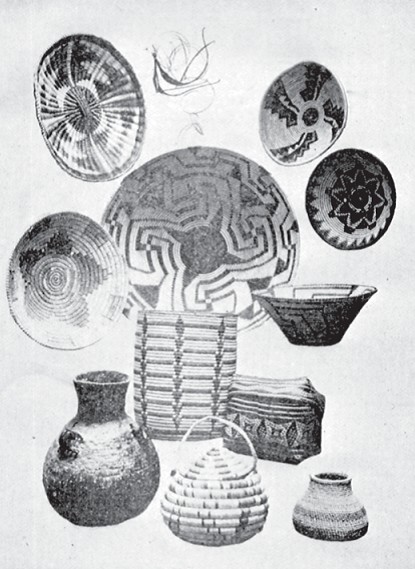 |
|
||
| Kellscraft
Studio Home Page |
Wallpaper
Images for your Computer |
Nekrassoff Informational Pages |
Web
Text-ures© Free Books on-line |
How to Make Baskets By MARY WHITE WITH A CHAPTER ON "WHAT THE BASKET MEANS TO THE INDIAN," BY NELTJE BLANCHAN NEW YORK DOUBLEDAY, PAGE & CO. 1902  GRAIN
PLAQUES — Of the Hopi, Apache, Havasupai and Pima Indians, from New
Mexico and Arizona. PIMA SCRAP BASKET — Arrow-head design, avowedly
adapted to white men's needs. RARE DOUBLE-WEAVE CHOCTAW COVERED
BASKET — From Louisiana. PAIUTE GUMMED WICKER WATER-JAR — The
handles of braided horse-hair. HOPI COILED YUCCA TREASURE BASKET —
At the top of plate are strips of sisal willow and the seed vessel of
the Martynia
or "Cat Claws," from which most of the
water-tight baskets in the Southwest are made.
TO A. D. T. PREFACE THE twisting and weaving of Nature's materials, grasses, twigs, rushes and vines into useful and beautiful forms seems almost instinctive in man. Perhaps it came to him as the nest-weaving instinct comes to birds — for at first he used it as they do, in the building of his house. Later shields and boats were formed of wicker work but how long ago the first basket was made no one is wise enough to tell us. Today Indian tribes in South America weave baskets from their native palms, South African negroes use reeds and roots, while the Chinese and Japanese are wonderful workmen in this as in other arts and industries; but basketry has come down to us more directly through the American Indian. Generations of these weavers have produced masterpieces, many of which are preserved in our museums, and the young basket maker need not go on long pilgrimages to study the old masters of his craft. Here at last, as in England, the value of manual training is being realized, and basketry is taking an important place; following the kindergarten and enabling the child to apply the principles he has learned there. He still works from the centre out and weaves as he wove his paper mats, but permanent materials have replaced the perishable ones and what he makes has an actual value. Basketry also fills the need for a practical home industry for children; so not only in school, club and settlement but on home piazzas in summer, young weavers are taking their first lessons. Though they are unlearned in woodcraft, and have not the magic of the Indian squaw in their fingertips, they can, and do, feel the fascination of basketry in the use of rattan, rush and raffia. It is hoped that this book may be a help in teaching them "How to Make Baskets." CONTENTS PREFACE CHAPTER I MATERIALS, TOOLS, PREPARATION, WEAVING CHAPTER II RAFFIA AND SOME OF ITS USES CHAPTER III MATS AND THEIR BORDERS CHAPTER IV THE SIMPLEST BASKETS CHAPTER V COVERS CHAPTER VI HANDLES CHAPTER VII WORK BASKETS CHAPTER VIII CANDY BASKETS CHAPTER IX SCRAP BASKETS CHAPTER X BIRDS' NESTS CHAPTER XI OVAL BASKETS CHAPTER XII THE FINISHING TOUCH CHAPTER XIII How TO CANE CHAIRS CHAPTER XIV SOME INDIAN STITCHES CHAPTER XV WHAT THE BASKET MEANS TO THE INDIAN LIST OF ILLUSTRATIONS Grain Plaques, Pima
Scrap Basket, Rare
Double-Weave Choctaw Covered Basket,
Paiute Gummed Wicker Water-Jar, Hopi Coiled Yucca Treasure Basket Raffia and Some of its Uses Mats and their Borders and the Simplest Baskets Weaving a Small Basket Covered Baskets Large Mat and Dolls' Furniture Basket With Handles Some Work Baskets Candy Baskets Birds' Nests Oval Baskets Caning in a Frame and on a Chair Twined Baskets Coiled Baskets Wicker Scoop, Basket Bowls, a Bottomless Bowl, Dinner Plates Klikitat and Quinaielt Carrying Baskets Alaskan Wallets, Carrying Baskets, Treasure Baskets, Plates and Aleutian Embroidered Wallet Apache Grain Plaques and Jars Rare Poma Ceremonial Basket, Mono Jar, Alaskan Treasure Basket, two Alaskan Carrying Baskets, a Squaw Cap, Cooking Basket
|